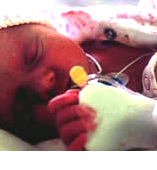|
Lines and Tubes
Most babies will have a thin plastic tube (intravenous or 'IV' cannula) inserted into a vein in an arm or leg to let staff give drugs and fluids into the blood stream.
 Sometimes, babies may also have longer, thinner lines placed in a vein to allow us to give a special form of nutrition ('TPN') into the blood stream if the baby is not having much milk yet. These 'long lines' can be inserted into the umbilical cord, arm or leg.
Babies can have an arterial line, which is placed in an artery in the umbilical cord, arm or leg and allows us to monitor their blood pressure very accurately, and take blood samples without repeated heel pricks.
Most babies will also have small feeding tubes placed (either via the nose or the mouth) directly into the stomach to allow us to feed them until they are old enough to suck and feed for themselves.
Occasionally, a baby may have a urinary catheter in place so that we can keep a close eye on their urine output. |



